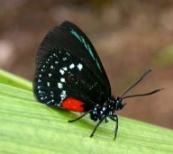Upcoming Events and field trips! January 2008
 January 26, 2008
January 26, 2008I had a great day at Everglades National Park this weekend with my classmates from Nova Southeastern University. We hit all the hot spots from Anhinga Trail to Flamingo Bay and our day ended a full ten hours later! Our instructor for this course, Everglades Ecology, is Dr. Jennifer Rehage. Her father-in-law Fred, who happens to be someone I know from the Board of Broward County Audubon Society, joined us, and brought his scope along. What fun that was! We got close-up views of the basking alligators, crocodiles, baby anhingas and osprey, and a Great Horned Owl and her offspring, that was a fuzzy ball of fluffy feathers high in an oak tree. Thanks to Dr. Joe Lopez who provided the pictures of the contented-looking alligator and tree snail, as well as the shot of me and classmates on Anhinga Trail.
 This is a Cormorant, and a foraging Woodstork, and the Florida Tree Snail. The Tree Snail and Woodstork are endangered
This is a Cormorant, and a foraging Woodstork, and the Florida Tree Snail. The Tree Snail and Woodstork are endangered  species that we were very happy to see.
species that we were very happy to see.
Of course, as evidenced from the photograph,a lot of people are not used to being out in fresh air  for long periods of time; I see this every day on tours...it takes and gives a lot more energy than most people see in a month to be out in the 'glades for a few hours!
for long periods of time; I see this every day on tours...it takes and gives a lot more energy than most people see in a month to be out in the 'glades for a few hours!
We’ll be doing field trips every Saturday for the next month; although I am literally in the ‘glades every day for work…I can’t complain about being there for school, too! I’ll let you know about the other class field trips, but in the meantime there for long periods of time; I see this every day on tours...it takes and gives a lot more energy than most people see in a month to be out in the 'glades for a few hours!
for long periods of time; I see this every day on tours...it takes and gives a lot more energy than most people see in a month to be out in the 'glades for a few hours!
are things that YOU could be enjoying, too, and I hope to see you at one of these events:
North American Butterfly Association, Broward County will have Dr. John Pipoly, Director of the Broward County UF Extension Office, speaking on the "Comparison of Habitats for our 4th of July Counts" including the butterflies and moths these plants attract, at our next meeting on February 14, 7:00 p.m. at the Broward County Extension Service Building, 3245 College Avenue Davie, Florida, USA 33314, (954) 370-3725. The Extension Building is on the West side of College Avenue just opposite the sign for the Florida Atlantic University campus, North of BCC's main entrance.
Join us from 6:30 to 7:00 pm for a social time with coffee and refreshments. This is a good time to check out the arriving plants at the raffle table and to purchase raffle tickets. If you have any extra plants that attract moths or butterflies and you'd like to share, please bring them along.
The meeting will begin at 7:00 and our program will begin at 7:15, with Dr. John Pipoly discussing the "Comparison of Habitats" for the upcoming Butterfly Counts, with an emphasis on the butterflies these plants attract. We tally butterflies in five different landscape areas for our 4th of July Counts and Dr. Pipoly will provide information about each of them.
Feb-24 Volunteers needed: Exotic invasive plant removals at John Williams Park, February 24th, 2008. I will be continuing work on exotic invasive plant removals at John Williams Park, 6101 Sheridan St, Hollywood. Bring your gloves, garden tools, water and sunscreen; I advise you wear long pants, and long sleeves as some of the work involves "diggin' in the dirt" kind of fun! I will be instructing in native as well as non-native plants, of course. We'll be concentrating on removing seedlings of Caesar's Weed, Rosary Pea, Balsam Pear and Air Potato from the areas around the new trail.
Feb-23 Native plant sale at Ann Kolb Nature Center, 751 Sheridan St. Hollywood, 9 am to 1 pm. This is a great opportunity to learn about butterfly, bird and wildlife plants for your yard. And the prices are right!
Feb-23 Native plant sale at Ann Kolb Nature Center, 751 Sheridan St. Hollywood, 9 am to 1 pm. This is a great opportunity to learn about butterfly, bird and wildlife plants for your yard. And the prices are right!









 And what could be more exciting to a lepidopterist than the sight of a Malachite butterfly shimmering in the sunlight?
And what could be more exciting to a lepidopterist than the sight of a Malachite butterfly shimmering in the sunlight? 



